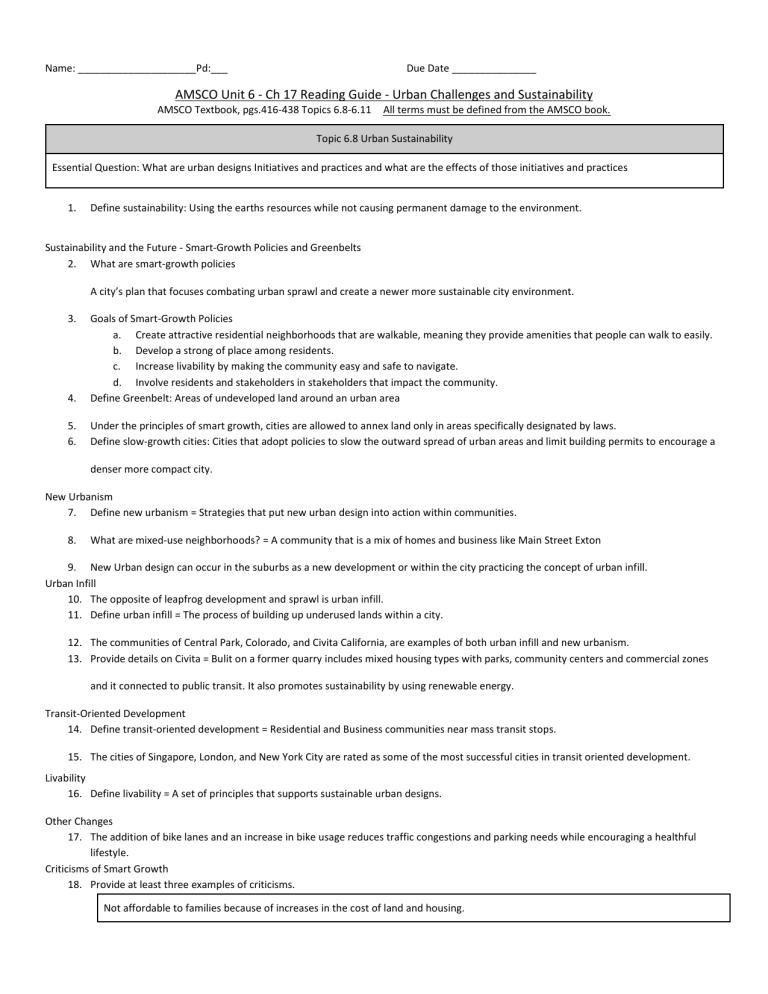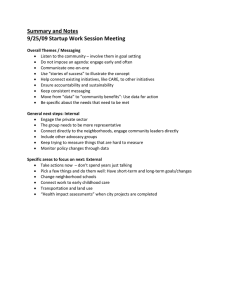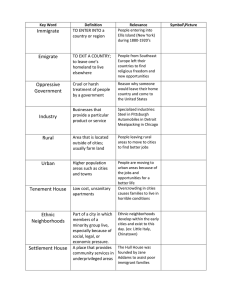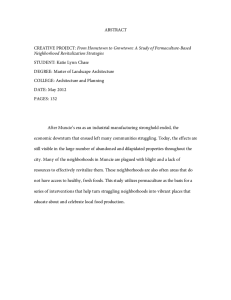
Name: _____________________Pd:___ Due Date _______________ AMSCO Unit 6 - Ch 17 Reading Guide - Urban Challenges and Sustainability AMSCO Textbook, pgs.416-438 Topics 6.8-6.11 All terms must be defined from the AMSCO book. Topic 6.8 Urban Sustainability Essential Question: What are urban designs Initiatives and practices and what are the effects of those initiatives and practices 1. Define sustainability: Using the earths resources while not causing permanent damage to the environment. Sustainability and the Future - Smart-Growth Policies and Greenbelts 2. What are smart-growth policies A city’s plan that focuses combating urban sprawl and create a newer more sustainable city environment. 3. 4. Goals of Smart-Growth Policies a. Create attractive residential neighborhoods that are walkable, meaning they provide amenities that people can walk to easily. b. Develop a strong of place among residents. c. Increase livability by making the community easy and safe to navigate. d. Involve residents and stakeholders in stakeholders that impact the community. Define Greenbelt: Areas of undeveloped land around an urban area 5. 6. Under the principles of smart growth, cities are allowed to annex land only in areas specifically designated by laws. Define slow-growth cities: Cities that adopt policies to slow the outward spread of urban areas and limit building permits to encourage a denser more compact city. New Urbanism 7. Define new urbanism = Strategies that put new urban design into action within communities. 8. What are mixed-use neighborhoods? = A community that is a mix of homes and business like Main Street Exton 9. New Urban design can occur in the suburbs as a new development or within the city practicing the concept of urban infill. Urban Infill 10. The opposite of leapfrog development and sprawl is urban infill. 11. Define urban infill = The process of building up underused lands within a city. 12. The communities of Central Park, Colorado, and Civita California, are examples of both urban infill and new urbanism. 13. Provide details on Civita = Bulit on a former quarry includes mixed housing types with parks, community centers and commercial zones and it connected to public transit. It also promotes sustainability by using renewable energy. Transit-Oriented Development 14. Define transit-oriented development = Residential and Business communities near mass transit stops. 15. The cities of Singapore, London, and New York City are rated as some of the most successful cities in transit oriented development. Livability 16. Define livability = A set of principles that supports sustainable urban designs. Other Changes 17. The addition of bike lanes and an increase in bike usage reduces traffic congestions and parking needs while encouraging a healthful lifestyle. Criticisms of Smart Growth 18. Provide at least three examples of criticisms. Not affordable to families because of increases in the cost of land and housing. It creates high population dense areas that often have higher crime rates and provides less privacy for residents. Smart growth can result in unintended segregation both ethnically and economically. Topic 6.9 Urban Data Essential Question: 19. Why do people live in cities? Quantitative Data 20. Define quantitative data. 21. How often does a census happen? 22. What does quantitative data identify? Also, provide examples Population Data in Urban Areas 23. Define census track 24. __________ and local data is shown on the chart. Qualitative Data 25. Define qualitative data 26. Provide examples of qualitative data questions. 27. What do geographers use qualitative and quantitative data for? Topic 6.10challenges of Urban Changes Essential Question: What are the causes and effects of geographic change within urban areas? 28. Cities can be places of poverty, violence, & environmental decay. Urban Challenges 29. Where does urban poverty exist? = Throughout the world Urban Housing Issues in Core Countries 30. What are three problems for inner-city residents? Poor quality Insufficient availability Significant unafforvabiliuty 31. Landlords often delay making expensive repairs, so over time, the overall quality of the housing suffers. 32. Where do geographers say poorer residential areas are in European and North American cities? = Near industrial regions built on the eastern side of cities 33. One reason for this disparity is the high number of female-headed households. Housing Discrimination and Segregation in the United States 34. Define red lining = A process by which banks refuse loans to those who want to purchase and improve properties in certain urban areas. 35. Laws now restrict redlining so that denial of a loan cannot happen for racial or cultural reasons. 36. Most of the suburban neighborhoods in the United States denied minorities the right to buy homes. 37. When did this become illegal? = 1968 38. Define segregation = People are separated based on there race, ethnicity, religion etc… 39. Define blockbusting = People of an ethnic group sold their homes upon learning that members of another ethnic group were moving into the neighborhood. 40. Segregated neighborhoods can sometimes become ghettos, areas of poverty occupied by a minority group as a result of discrimination. Government Support for Affordable Housing 41. Define inclusionary zoning = Developers set aside a percentage of housing for low income renters or buyers. 42. Many provided decent housing and a solid sense of community. 43. What allowed children access to better local schools? = Scattered sight where the government provides rental assistance for individuals to disperse public housing throughout the area. Urban Renewal 44. What is urban renewal? = A policy which allowed governments to clear out inner city slums. 45. Governments often use the legal concept of eminent domain which allows the government to claim private property from individuals, pay them for the property and the use the land for public good. Gentrification 46. Define gentrification = The process of converting a low income renter occupied inner city into a wealthier owner occupied area of a city. 47. Newcomers to gentrified areas are a. Young urban professionals with high-paying jobs b. LGBTQ+ looking for neighborhoods that are more inclusive, accepting, and safe. c. Older couples whose children have moved out. 48. Negative aspects: Gentrification can displace residents, create space that exclude minorities or the poor, and eliminate the historical cultural landscape of previous residents. 49. What pushes out the original residents? Rising rents & Rising Taxes Housing in Periphery Countries 50. Define informal settlements = Densely populated areas built without coordinated planning and without sufficient public services for water, electricity, and sewage. 51. Residents often lack land tenure , or the legal protection of contracts to show ownership of the land or structures. 52. Define disamenity zone 53. Zones of abandonment will often have empty decaying buildings, poor sanitation, high crime rates, and vandalism. 54. What is a brownfield and provide examples? = A type of abandonment when factories leave an area. An example would be in Detroit Michigan there’s an abandoned automobile factory which lead to a zone of abandonment 55. What is environmental injustice (environmental racism) = The disproportionate exposure of minorities and the poor to pollution and its impacts plus the unequal protections of their rights under the law. Gated or Walled Communities 56. Define gated communities = A walled or fenced neighborhood with limited access and entry points. 57. The growth of gated communities can reinforce separation in economies, social status, ethnicity, and even political views. Homelessness 58. In the U.S., the unhoused population was once primarily single men, but the problem expanded in t he late 20th century to include more women and children. Services 59. Public services such as parks and swimming pools might be rare in urban neighborhoods with low tax basis. Food Deserts 60. What are food deserts? = Places usually in poor urban areas where fresh healthful food isn’t available so families have to eat unhealthy cheap fast food instead. Political Challenges of Urban Regions 61. The system of federalism has many strengths but its fragmented nature of governance between states, countries, cities and neighborhoods often makes collaboration difficult. Topic 6.11 Challenges of Urban Sustainability Essential Question: Environmental Problems in the Cities 62. Stresses are placed on _________ when people modify the environment and in the ____ they respond to those _______________. Environmental Effects of Cities a. Define Urban Canyons b. Soils are __________ and replaced with structures that are impermeable to ______, such as buildings, ________, and __________ lots. As a result, rainwater runs off instead of _________ into the groun, causing urban flooding. c. Water demand ___________ as people move to _____, what can strain existing water _______. Water if often diversity from agricultural use to _________ ______. d. The concentration of buildings and ___________ in the center of the city creates and _________ ___________, an area of a city _______ than surrounding areas. Cities and Wildlife 63. Define urban wildlife Pollution 64. As countries develop, _____ pollution increased because of more _________ activity and more ________ from a growing number of cars. 65. The result is ______, a severe issue in ______ cities such as Los Angeles, _______, ________ and Mexico city. This is caused by Idling cars on the roads in rush hour traffic. 66. According to the the World Health Org, ____ pollution results in __ million deaths a year. Urban Sprawl 67. Define urban sprawl 68. Define ecological footprint Responses to Urban Sustainability - Regional Planning and Brownfields 69. Industry once _________ in central cities of _______________ countries. 70. Why did manufacturing move to the suburbs?____________________ 71. Define brownfields Redevelopment 72. Define urban redevelopment 73. ________________ can break up and eliminate _________ neighborhoods. Geographic Perspective: Is urban or rural living more sustainable? 74. Explain why farming is essential to maintaining cities 75. Explain two reasons why compact urban areas are more sustainable than suburbs. Think as a geographer: Comparing Cities 76. Describe the scale of the data for Median Age. 77. In which of the major urban areas listed on the chart would you prefer to live? Use the data from the chart to support your answer.



